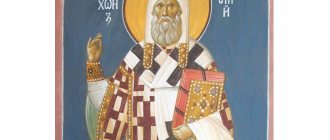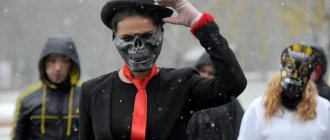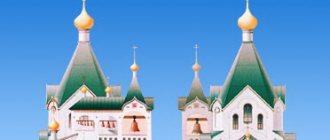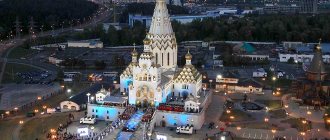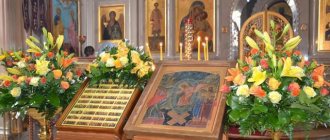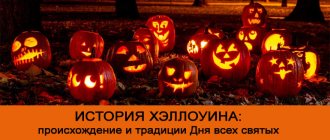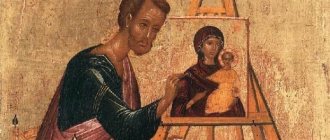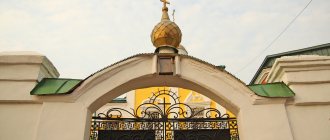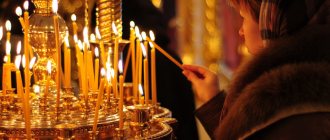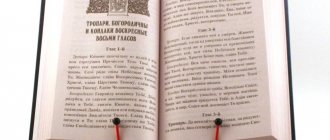In addition to the images that depict certain specific clergy (Jesus, the Mother of God, apostle-evangelists, martyrs and prophets), there are collective icons. The entire Army of God is symbolically depicted on them, and by praying in front of them, we can turn to our patron saint for help, as if it were a personal icon.
The essence of the name
Why is the image called “Icon of All Saints”? At baptism, every Christian receives a personal heavenly protector, a patron who protects him on the path of life and to whom a churchgoer can turn in prayer with any need or request. In honor of this patron, he is given a new name. However, the icon of All Saints is a universal image, and this is the essence of its name. Whoever your heavenly guardian is - Archangel Michael, Nicholas the Wonderworker or Mother Matrona - your prayer in front of this image will be heard by each of them. Ask for support at all life's crossroads - and you will definitely feel it! What prayers did the Icon of All Saints hear most often? Probably: “Heavenly Fathers, merciful intercessors, pray to God for us!”
What is a patron saint for?
From the moment of baptism, a person acquires an inextricable connection with his patron saint. The patron saint becomes for the believer a spiritual mentor, assistant and protector throughout his life, a messenger of the Will of God, one who helps bring his prayers and petitions to God.
The patron saint, as a teacher and elder brother (“sister”), constantly cares for you before our Father, lifting up prayers to Him for you and your petitions. Therefore, it is believed that by turning prayers to your patron saint, there is a greater chance of being heard faster.
Our heavenly intercessor protects us from troubles, leprosy and temptations of the evil one, protects us from bad deeds, helps us in illness and difficult life circumstances. People often turn to Him for blessings before starting long and difficult tasks and making important decisions.
Description of the image
There are many different icon image lists. The oldest ones date back to the 5th-7th centuries, and they were made on Mount Athos. Here, for example, is what the icon of All Saints looks like on one of the Russian samples of the 18th century: at the top is the Holy Trinity (God the Father, God the Son and the Holy Spirit). The Father is depicted in the center, the Son is on the right, and the Spirit (in the form of a Dove) is above both. The second row of figures, that is, somewhat lower, consists of the Mother of God, who is called the Lady Theotokos, Intercessor of all sinners, and John the Baptist. In addition to them, the icon of All Saints, which we are describing, includes John the Baptist and the faces of other lambs of God.
How to choose a personalized icon by name and date of birth?
How can you recognize your patron saint? - It’s not uncommon for even an Orthodox person who has lived a long life to ask such a question. People also face this question when they purchase a personalized icon for themselves or their loved ones.
It's not as difficult as you think. Although, of course, there are special cases and exceptions.
The patron saint will be the saint who bears the same name.
However, most often, if you take the name of a saint, it turns out that in Orthodoxy there are several saints with that name. So, for example, the widespread name Oleg - there are two saints Oleg: the Venerable Oleg of Bryansk and the holy Prince Oleg of Ryazan. There are even more “confusing” cases - the name John (“Ivan”). There are 69 saints with this name. How then to choose your saint?
There is a rule for determining a personalized icon by date of birth (and not just by name). The date of birth is compared according to the calendar with the days of remembrance of the saints of the same name, and the saint whose memorial day will follow the person’s birthday will be the patron saint.
Example:
Name Oleg, day and month of birth - April 5.
Among the Orthodox there are 2 saints with the name Oleg: the Venerable Oleg of Bryansk (memorial day October 3) and the holy Prince Oleg Ryazansky (memory day July 18).
In this case, Oleg Ryazansky will be considered the patron saint, since his memorial day comes after his birthday (after April 5).
What features are there when determining the patron saint?
- It is necessary to take into account that the date of memory of a saint can be indicated in two (or one of 2) forms - according to the new style and according to the old (Julian calendar). Often in Orthodox sources the date exactly corresponds to the old style (church calendar).
- The spelling of names has changed over the centuries, but the names of the saints have remained in the old spelling. For example: Tatyana is old. Tatiana, Ivan – old. John, Yana - old. Joanna, Julia - Julia, etc.
- Some names, although they have “derivatives,” but church names are pronounced only in one way, for example: Yuri-Georgiy, Sofia - Sophia, etc.
- There are people with names that are not in the calendar, for example Yaroslav, Timur, etc. In these cases, the patron saint will most likely be considered one of the saints who bears a different name, but whose feast day falls on the person’s birthday or baptism.
There are also a few other features. So, for example, if Vladimir is baptized on July 28, then regardless of when the birthday was, the patron saint will most likely be Equal-to-the-Apostles Prince Vladimir, since baptism takes place on the day of remembrance of this saint.
In any case, if you have doubts about how to identify your saint and how to choose a personal icon by name, then it is best to contact a priest in the church who will help you understand all the details and features.
Our invisible intercessors
Who are they, our invisible saviors? Let's take a closer look at the photo of the icon of All Saints and think about the individuals who look at us strictly and at the same time meekly and compassionately. Saints are people who, during their lifetime, pleased the Lord with their actions, firmness in faith and deeds that glorified the Almighty, performed for His glory. After their physical death, they were taken by God to heaven to pray before Him for our intercession.
Wedding couple.
An icon pair consisting of an icon of the Mother of God (the Most Holy Theotokos) and the Savior (the Lord Pantocrator). The wedding couple is given to the newlyweds, and later these icons are used to bless the newlyweds during the sacrament of Wedding (marriage). The wedding couple helps the newlyweds in the well-being of family life, preserving the marital union, creating strong relationships, understanding each other, overcoming family adversity and troubles, the health and well-being of the family and its offspring.
The most common wedding couples are with the Kazan and Vladimir Mother of God, however, others can also act as the image of the Mother of God in a pair: Iverskaya, Tikhvinskaya, Yaroslavl.
Hierarchy of heaven
The saints include, first of all, prophets. From God himself they received a wonderful gift - to see the future, to see events that should happen hundreds and thousands of years later. The most important of them is the return of the Savior to earth. Among the prophets, Elijah is most revered (the prayer to the icon of All Saints and to him is effective in July-August, on the 20th and 2nd, depending on the style). In addition, Orthodox Christians respect John the Baptist, the days of whose veneration are June 24 (July 7) and August 29 (September 11).
Prayer before the icon
Holy God and rest in the saints, glorified by the angels with a thrice-holy voice in heaven, praised on earth by man in His saints, giving grace to each by Your Holy Spirit according to the bestowal of Christ, and by that ordaining to the Church of Your Holy Ones apostles, prophets, and evangelists , you are shepherds and teachers, whose word of preaching, to You who acts all in all, has been accomplished in many ways, saints in every generation and generation, having pleased You with various benefactors, and to You, having left us the image of your good deeds, in the joy that has passed, prepare, in He himself was tempted, and he helped us those who were attacked. All these saints and (the name of the saint) remembering and praising their godly lives, I praise You Samago, who acted in them, and believing in Your goodness, the gift of being, I diligently pray to You, Holy of Holies, grant to me a sinner to follow their teaching, life, love, faith, long-suffering, and their prayerful help, and moreover Your all-effective grace, the heavenly ones with them will be honored with glory, praising Your Most Holy Name, the Father and the Son and the Holy Spirit forever. Amen.
( 3 ratings, average: 4.33 out of 5)
Apostles - messengers of God
The apostles are those people who personally knew Christ, were his disciples, accompanied the Son of God throughout the land of Judea, and wrote down his teachings. We know the 12 apostles by name, how they came to know the Living God and how they found themselves in Christ. After the death of their teacher, the apostles went to different parts of the world to preach new knowledge. There is also a hierarchy among them. The main ones, or the supreme ones, are recognized as Paul and Peter. The evangelists, that is, the compilers of the Holy Scriptures, are Luke, Matthew, John, Mark. Some saints are equated to apostles in terms of their mission. They were not personal disciples of Christ, but in different eras they propagated His teachings. These are the Greek kings Constantine and Elena, the Russian princes Vladimir and Olga, and the Georgian enlightener Nina.
How to design a personalized icon.
When ordering a personalized icon, you can provide different designs for the icon. So, when painting an icon, you can gild the entire background with gold leaf, add characters, carve on gesso, paint the fields of the icon with a pattern, etc. This creates uniqueness; such an icon looks more festive and beautiful.
Among the external decoration of icons, we offer icon cases. They not only preserve the icon for centuries from external environmental influences, but are also an element of icon decoration. Thus, a correctly selected icon case can emphasize the plot of the icon, making it brighter and more elegant
View our full catalog of personalized icons.
Clan of Martyrs
Many saints depicted on the icon deserved such a great honor not only because they brought the Light of Truth to the masses, but also suffered cruelly for it. These include Christian martyrs. Those who endured terrible mockery, abuse and torture are called great martyrs. This is the famous healer Panteleimon, whose image in the popular consciousness has merged with the Archangel Raphael, the healer of God; and St. George, bearing the great name Victorious; as well as Christian sufferers - Catherine and Varvara. The canonical texts talk about the first martyrs - Christians, that is, those who were the first of the huge number of victims to take the blow of persecution and persecution - Stephen and Thekla. A special place among the saints in the icon is occupied by confessors - Christians who, with their own righteous lives, proved the justice of God’s covenants.
How does a personalized icon differ from a dimensional icon?
A measured icon is a kind of separate type of nominal icons. Both depict a named patron saint. The differences lie in the size and scale of the image of the saint. Thus, a personal icon of a saint can be of any size - from pocket and travel to lectern. A measured icon, according to the tradition of the old times of Rus', is always made in height to the height of the child at birth. In very ancient times, our ancestors often made a measured icon not only in height, but also in width of the baby (over the shoulders). This attitude towards measures came from a worldview - measures were not an absolute value, but a relative one and were correlated with the proportions of the person himself and his body parts (palm, span, inch, elbow, etc.).
On dimensional icons, the patron saint is depicted only in full length (from head to toe); nominal icons suggest a different scale of depiction of the saint: full-length, waist-length, shoulder-length, head-length.
People "for Christ's sake"
These include the holy companions who pleased the Lord with their deeds:
- This is Nicholas, so respected by both Orthodox and Catholics: endowed with great abilities, he, for the glory of God, performed many miracles, for which he received the title of Wonderworker. John Chrysostom, Gregory the Theologian and others, called teachers of the Christian Church.
- Those who became like God, that is, the saints - Sergius of Radonezh, Seraphim of Sarov, beloved by all Orthodox people. And to this day, faith in them is strong and unshakable.
- The righteous are family people who lived according to the laws of Christianity and tried with all their might to keep the covenants of God. These are, first of all, the Old Testament prophets, Mary’s parents, her husband, Joseph, Peter and Fevronia of Murom and many others.
- Fools and unmercenaries who help others morally and financially without payment, without expecting any reward, for Christ's sake: St. Basil and Mother Matrona, Ksenia of Petersburg and others.
This is how amazing it is - the icon of All Saints!
The faces of saints located on the icon of All Saints, with their names and photos
Knowing how certain Saints looked and were depicted, you can recognize them in any image. In the lower half of such icons there are many Saints, who are divided into groups. In the bottom row are the Old Testament Prophets, and nearby you can see the Holy Apostles Peter and Paul.
In addition to the prophets and apostles, in the lower ranks there are also martyrs and martyrs. Among the martyrs you can recognize the Great Martyr Catherine.
The icon painter could depict in the image of the saint details that were characteristic of him. From such details you can recognize the name of the saint, if it is not inscribed on the icon. Among the saints you can recognize Basil the Great, as well as John Chrysostom.
